Investigation of the Impact of Improving the Hydrological Quality of Permeable Asphalt Pavement Based on the SWMM
Abstract
1. Introduction
2. Model Construction
2.1. Permeable Pavement Structure
2.2. SWMM
2.3. Parameter Setting
2.3.1. Catchment Area Parameters
- (1)
- The node depth was specified as 2 m, with the internal bottom elevation ranging between 15 m and 20 m. The overloading depth was set to 1 m, and the water storage area was defined as 100 m2. The discharge node was not configured without an anti-tide gate, and the outlet type was selected as free discharge. The pipe cross-sectional area was modeled as circular, with a maximum depth of 1 m. The roughness coefficient was 0.015.
- (2)
- Puddle storage refers to the depth of water accumulated in the surface depressions [35], which can be classified into puddle storage for permeable areas and impermeable areas. For permeable pavements, such as permeable asphalt, the puddle storage is primarily influenced by the mean tectonic depth (MTD) of the pavement surface. Accordingly, the initial puddle storage was set to 1.9 mm for impermeable surfaces and 4.50 mm for permeable surfaces.
- (3)
- Manning’s roughness coefficient, also known as the Manning coefficient, represents the hydraulic resistance of the road surface or pipe wall to water flow [36]. It includes coefficients for permeable zones, impermeable zones, and the pipe network. The recommended values from the SWMM and the model-adopted values are summarized in Table 1.
2.3.2. Infiltration Model Parameters
- (1)
- The maximum infiltration rate was defined as the infiltration value at the onset of rainfall [37], which depended on the initial water content of the soil and was therefore difficult to estimate. For clay soils with dense vegetation, the maximum infiltration rate was represented by a value of 2 in/h, which was about 51 mm/h.
- (2)
- Minimum infiltration rate [38]: The minimum infiltration rate used the hydraulic conductivity of the saturated soil, which was the hydraulic conductivity of the soil at saturated conditions. The value is usually set as the saturated hydraulic conductivity of the soil, and the saturated hydraulic conductivity of the pulverized clay soil was 0.02 in/h, which was about 0.5 mm/h.
- (3)
- Decay coefficient: This parameter refers to the rate of decline of the infiltration rate from the maximum initial value to the minimum value. Typical values range from 2 to 7, and the attenuation coefficient was set at 5.
- (4)
- Drainage time (days): This parameter indicates the time required for fully saturated soil to drain completely. Typical values range from 2 to 14 days. In this paper, the drainage time was taken as 10.
2.3.3. LID Parameter Settings
3. Results and Discussion
3.1. Hydrological Simulation Results
3.1.1. Surface Runoff Reduction Effect
3.1.2. Comparison of Seepage and Storage Capacity
3.1.3. Drainage System Loading Effects
- (1)
- Drainage node flow load
- (2)
- Pipe section loading
3.2. Water Quality Simulation Results
3.2.1. Analysis of Pipeline Pollutant Accumulation Processes
3.2.2. Effectiveness in Purifying Surface Runoff Water Quality
3.2.3. Effectiveness of Water Quality in the Drainage Network
4. Conclusions
- (1)
- A comprehensive analysis was conducted on the properties of various materials used in the structural layers of permeable asphalt pavements, considering the functional requirements of urban pavements. Based on this analysis, two semi-permeable asphalt pavements were designed: SPAP1, comprising PAC13, PAC20, asphalt-stabilized crushed stone, a waterproof sealing layer, and dense cement-stabilized crushed stone, and SPAP2, consisting of PAC13, PAC20, asphalt-stabilized crushed stone, porous cement-stabilized crushed stone, and a waterproof sealing layer. Additionally, two fully permeable asphalt pavements were designed: PAP1, comprising PAC13, PAC20, cement-stabilized crushed stone, graded crushed stone, and permeable geotextile; and PAP2, consisting of PAC13, PAC20, porous cement concrete, cement-stabilized crushed stone, and permeable geotextile. The void ratios and permeability coefficients of specimens made from these different materials were also measured.
- (2)
- SPAP1 delayed the peak runoff by an average of 10 min, achieving a surface runoff reduction ranging from 44% to 100%. SPAP2 delayed the peak runoff by an average of 1 h 10 min, with a surface runoff reduction ranging from 97% to 100%. No surface runoff was observed for PAP1 and PAP2, indicating a complete (100%) reduction in surface runoff.
- (3)
- SPAP1 achieved a maximum reduction in inflow to the sink node ranging from 37% to 73%, whereas SPAP2 achieved a reduction ranging from 55% to 78%. Similarly, PAP1 and PAP2 achieved a maximum reduction in inflow to the sink node within the range of 55% to 78%.
- (4)
- SPAP1 reduced flow loading to the main pipe by 36–100% and water pressure loading by 25% to 50% and attained a maximum storage depth of 90 mm. SPAP2 reduced flow loading by 67–100% and water pressure loading by 50% to 64% and reached a maximum storage depth of 160 mm. PAP1 and PAP2 reduced flow loading to the main pipeline by 67–100% and water pressure loading by 50% to 64% and achieved groundwater recharge ranging from 61 mm to 177 mm.
- (5)
- SPAP1 reduced pollutants by up to 2.05 kg of COD, 0.26 kg of NH3-N, 0.022 kg of PP, and 2.4 kg of SS, with a total pollutant removal rate ranging from 28% to 78%. SPAP2 reduced pollutants by up to 5.3 kg of COD, 0.72 kg of NH3-N, 0.05 kg of PP, and 6.3 kg of SS, with a total pollutant removal rate ranging from 68% to 79%. PAP1 and PAP2 reduced pollutants by up to 5.92 kg of COD, 0.752 kg of NH3-N, 0.06 kg of PP, and 6.912 kg of SS, with a total pollutant removal rate ranging from 77% to 81%.
Author Contributions
Funding
Data Availability Statement
Conflicts of Interest
References
- Chu, Y.; Shi, Y. Optimization Simulation of Sponge City Landscape Pattern based on SWMM Model. Acad. J. Manag. Soc. Sci. 2025, 11, 1–7. [Google Scholar] [CrossRef]
- Guan, X.; Wang, J.; Xiao, F. Sponge city strategy and application of pavement materials in sponge city. Clean. Prod. 2021, 303, 127022. [Google Scholar] [CrossRef]
- Wang, J.; Zhou, X.; Wang, S.; Chen, L.; Shen, Z. Simulation and Comprehensive Evaluation of the Multidimensional Environmental Benefits of Sponge Cities. Water 2023, 15, 2590. [Google Scholar] [CrossRef]
- Ahmed, G.H.; Aziz, Q.S.; Wu, B.; Ahmed, M.S.; Jha, K.; Wang, Z.; Nie, Y.; Huang, T. Application of Sponge City for Controlling Surface Runoff Pollution. Asian J. Environ. Ecol. 2024, 23, 1–23. [Google Scholar] [CrossRef]
- Alhassan, I.; Katharine, B.; Ehsan, S. Waterways transformation and green stormwater infrastructure: Enabling governance for Adelaide’s River Torrens Catchment, Australia. Int. J. Water Resour. Dev. 2024, 40, 33–56. [Google Scholar] [CrossRef]
- Li, S.; Leitao, J.P.; Wang, Z.; Bach, P.M. A drainage network-based impact matrix to support targeted blue-green-grey stormwater management solutions. Sci. Total Environ. 2023, 912, 168623. [Google Scholar] [CrossRef]
- Saumya, A.; Arun, K. Green Infrastructure for Sustainable Stormwater Management in an Urban Setting Using SWMM-Based Multicriteria Decision-Making Approach. J. Hydrol. Eng. 2024, 29, 04023044. [Google Scholar] [CrossRef]
- Sousa, M.; Almeida, D.M.; Fael, C.; Bentes, I. Permeable Asphalt Pavements (PAP): Benefits, Clogging Factors and Methods for Evaluation and Maintenance—A Review. Materials 2024, 17, 6063. [Google Scholar] [CrossRef]
- Wei, Y.; Cao, X.; Li, J.; Chang, Y. Greenhouse gas, water, and economic implications of permeable pavements: Quantification for pilot sponge cities in China. J. Clean. Prod. 2024, 471, 143424. [Google Scholar] [CrossRef]
- Xu, G.; Fan, J.; Ma, T.; Zhao, W.; Ding, X.; Wang, Z. Research on application feasibility of limestone in sublayer of Double-Layer permeable asphalt pavement. Constr. Build. Mater. 2021, 287, 04023044. [Google Scholar] [CrossRef]
- Sun, Y.; Guo, R.; Wang, X.; Ning, X. Dynamic response characteristics of permeable asphalt pavement based on unsaturated seepage. Int. J. Transp. Sci. Technol. 2019, 8, 403–417. [Google Scholar] [CrossRef]
- Zhou, J.; Pang, Y.; Du, W.; Huang, T.; Wang, H.; Zhou, M.; Liu, J. Review of the development and research of permeable pavements. Hydrol. Process. 2024, 38, e15179. [Google Scholar] [CrossRef]
- Yang, Q.; Hu, J.; Beecham, S. Effect of Slope on Stormwater Infiltration into Porous Asphalt Pavements. Sustainability 2024, 16, 589. [Google Scholar] [CrossRef]
- Nina, S.; Joacim, L.; Sara, J.; Sami, K.; Mats, G. Effects of a porous asphalt pavement on dust suspension and PM10 concentration. Transp. Res. Part D 2023, 123, 103921. [Google Scholar] [CrossRef]
- Jiang, W.; Sha, A.; Xiao, J.; Li, Y.; Huang, Y. Experimental study on filtration effect and mechanism of pavement runoff in permeable asphalt pavement. Constr. Build. Mater. 2015, 100, 102–110. [Google Scholar] [CrossRef]
- Chen, S.; Lin, X.; Zheng, C.; Guo, X.; Chen, W. Evaluation of Siltation Degree of Permeable Asphalt Pavement and Detection of Noise Reduction Degree. Appl. Sci. 2020, 11, 349. [Google Scholar] [CrossRef]
- Qin, H.; Li, Z.; Fu, G. The effects of low impact development on urban flooding under different rainfall characteristics. J. Environ. Manag. 2013, 129, 577–585. [Google Scholar] [CrossRef] [PubMed]
- Luan, Q.; Fu, X.; Song, C.; Wang, H.; Liu, J.; Wang, Y. Runoff Effect Evaluation of LID through SWMM in Typical Mountainous, Low-Lying Urban Areas: A Case Study in China. Water 2017, 9, 439. [Google Scholar] [CrossRef]
- Zhang, K.; Chui, T.F.M.; Yang, Y. Simulating the hydrological performance of low impact development in shallow groundwater via a modified SWMM. J. Hydrol. 2018, 566, 313–331. [Google Scholar] [CrossRef]
- Qin, F.; Huang, L.; Qi, X.; Sun, L.; Cui, J.; Wei, Y. Optimal LID Designs Based on SWMM Simulations Regarding the Sustainable Efficacy of Stormwater Management in Port Areas. Sustainability 2025, 17, 2544. [Google Scholar] [CrossRef]
- Jia, J.; Wang, J.; Cao, S.; Wang, J.; Zhang, S.; Guo, Y. SWMM Simulation of the Stormwater Volume Control Performance of Rainwater Harvesting Systems. J. Hydrol. Eng. 2025, 30, 04024052. [Google Scholar] [CrossRef]
- Helene, S.; Britta, S. Simulating Effectiveness of Low Impact Development (LID) for Different Building Densities in the Face of Climate Change Using a Hydrologic-Hydraulic Model (SWMM5). Hydrology 2025, 12, 200. [Google Scholar] [CrossRef]
- Li, Z.; Cao, Y.; Zhang, J.; Liu, W. Urban rainfall characteristics and permeable pavement structure optimization for sponge road in North China. Water Sci. Technol. A J. Int. Assoc. Water Pollut. Res. 2021, 83, 1932–1945. [Google Scholar] [CrossRef]
- Zhang, X.; Xu, Z.; Lv, Q.; Xu, T. Hydrodynamic self-cleaning behaviors of double-layer drainage asphalt pavement. J. Clean. Prod. 2025, 486, 144582. [Google Scholar] [CrossRef]
- Xiao, J.; Wang, T.; Hong, J.; Ruan, C.; Zhang, Y.; Yuan, D.; Wu, W. Experimental Study of Permeable Asphalt Mixture Containing Reclaimed Asphalt Pavement. Sustainability 2023, 15, 10676. [Google Scholar] [CrossRef]
- Abdalla, E.M.H.; Muthanna, T.M.; Alfredsen, K.; Sivertsen, E. Towards improving the hydrologic design of permeable pavements. Blue Green Syst. 2022, 4, 197. [Google Scholar] [CrossRef]
- Sabbaghian, J.R.; Fereshtehpour, M.; Hosseinabad, G.R.M. Integrated hydrologic-economic modeling for urban flood risk mitigation using SWMM, HEC-RAS, and HAZUS: A case study of the Bronx river watershed, NYC. Sustain. Water Resour. Manag. 2025, 11, 97. [Google Scholar] [CrossRef]
- Bragg, A.M.; Poudel, A.; Vasconcelos, G.J. Comparing SWMM and HEC-RAS Hydrological Modeling Performance in Semi-Urbanized Watershed. Water 2025, 17, 1331. [Google Scholar] [CrossRef]
- Yang, L. Research on the Simulation and Evaluation of Urban Waterlogging Prevention and Control Based on SWMM Model. Eng. Technol. Res. 2023, 8, 195–197. [Google Scholar]
- Zhao, Y.; Zhang, J.; Li, T.; Xia, W. Parameter Sensitivity Analysis and Method Comparison of Rainfall Runoff Model. China Water Wastew. Water 2021, 37, 114–120. [Google Scholar]
- Morgenroth, J.; Buchan, G.; Scharenbroch, C.B. Belowground effects of porous pavements—Soil moisture and chemical properties. Ecol. Eng. 2013, 51, 221–228. [Google Scholar] [CrossRef]
- Serizawa, H.; Amemiya, T.; Itoh, K. River channel networks created by Poisson Equation and Inhomogeneous Permeability Models (II: Horton’s law and fractality. J. Adv. Simul. Sci. Eng. 2019, 6, 386–415. [Google Scholar] [CrossRef]
- Steffen, D.; Roland, L.; Nanna, R.; Lina, J.; Karsten, A.N. Initial conditions of urban permeable surfaces in rainfall-runoff models using Horton’s infiltration. Water Sci. Technol. A J. Int. Assoc. Water Pollut. Res. 2018, 77, 662–669. [Google Scholar] [CrossRef]
- Assaf, M.N.; Salis, N.; Manenti, S.; Tamellini, L.; Creaco, E.; Todeschini, S. Optimizing hydrological modelling on real urban catchment: Impact of calibration data selection and objective function. J. Hydrol. 2025, 662 (Part A), 133821. [Google Scholar] [CrossRef]
- Xu, J.; Du, X.; Zhao, X.; Li, L. Analytical Stability Analysis of Rainfall-Infiltrated Slopes Based on the Green–Ampt Model. Int. J. Geomech. 2023, 23, 04022277. [Google Scholar] [CrossRef]
- Sun, Y.; Huang, Y. Study on the value of runoff coefficient of greenland in Jiaxing region under the condition of sponge city. Water Waste Water Eng. 2020, 56, 107–110. [Google Scholar]
- Zhou, Z.; Liu, S.; Sun, L.; Liu, Y. Unraveling nonlinear urban waterlogging responses to rainfall structure: A data-driven analysis in a highly urbanized megacity. J. Hydrol. 2025, 664 Pt A, 134349. [Google Scholar] [CrossRef]
- Galli, A.; Peruzzi, C.; Beltrame, L.; Cislaghi, A.; Masseroni, D. Evaluating the infiltration capacity of degraded vs. rehabilitated urban greenspaces: Lessons learnt from a real-world Italian case study. Sci. Total Environ 2021, 787, 147612. [Google Scholar] [CrossRef]
- Yun, D.; Chen, Y.; Jia, H.; Wang, Q.; Chen, Z.; Xu, C.; Li, Q.; Wang, W.; Yang, Y.; Fu, G.; et al. Sponge city practice in China: A review of construction, assessment, operational and maintenance. J. Clean. Prod. 2021, 280, 124963. [Google Scholar] [CrossRef]
- Hua, P.; Yang, W.; Qi, X.; Jiang, S.; Xie, J.; Gu, X.; Li, H.; Zhang, J.; Krebs, P. Evaluating the effect of urban flooding reduction strategies in response to design rainfall and low impact development. J. Clean. Prod. 2020, 242, 118515. [Google Scholar] [CrossRef]
- Liu, C.; Xie, T.; Yu, Q.; Niu, C.; Sun, Y.; Xu, Y.; Luo, Q.; Hu, C. Study on the response analysis of LID hydrological process to rainfall pattern based on framework for dynamic simulation of urban floods. J. Environ. Manag. 2024, 351, 119953. [Google Scholar] [CrossRef] [PubMed]

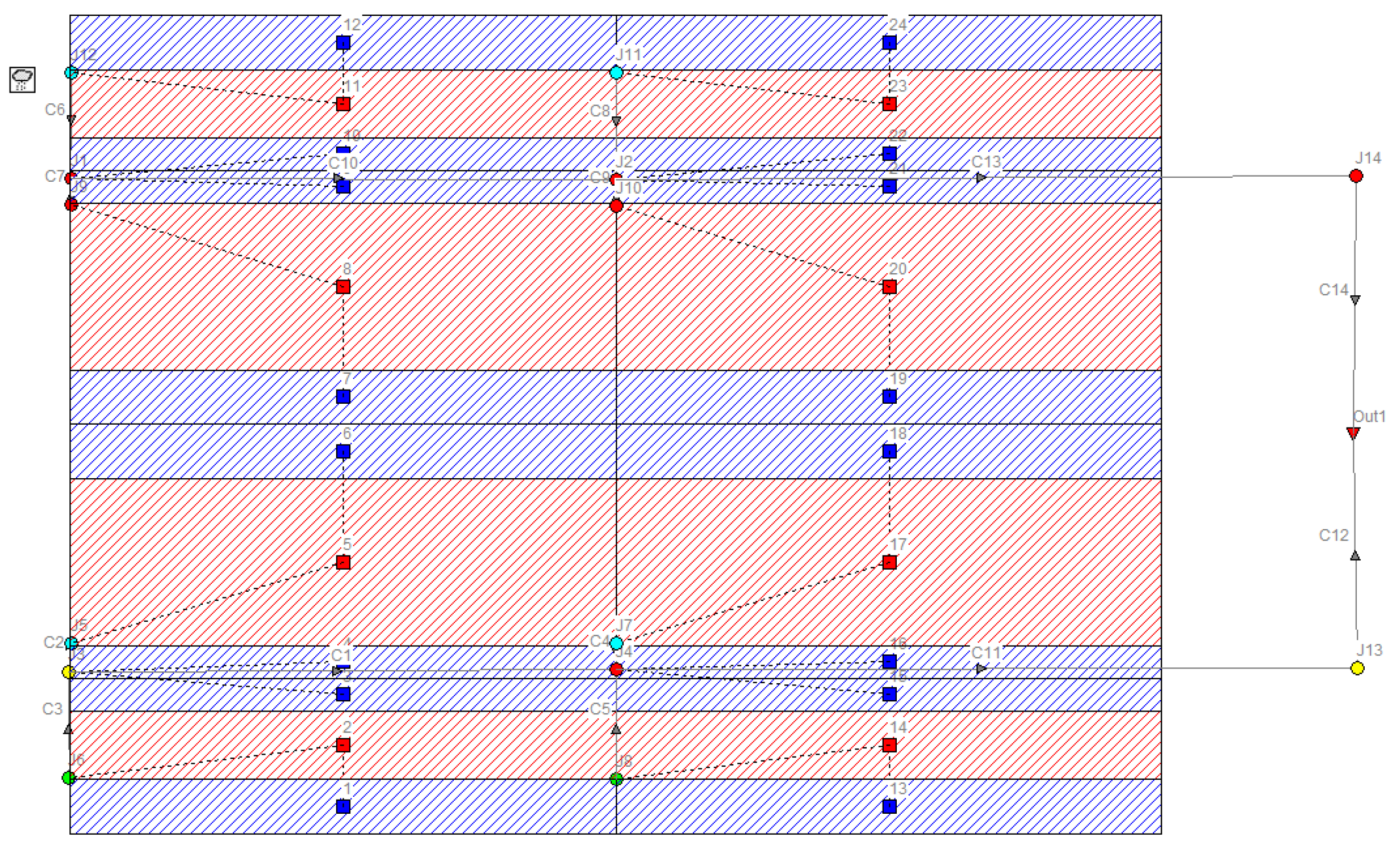
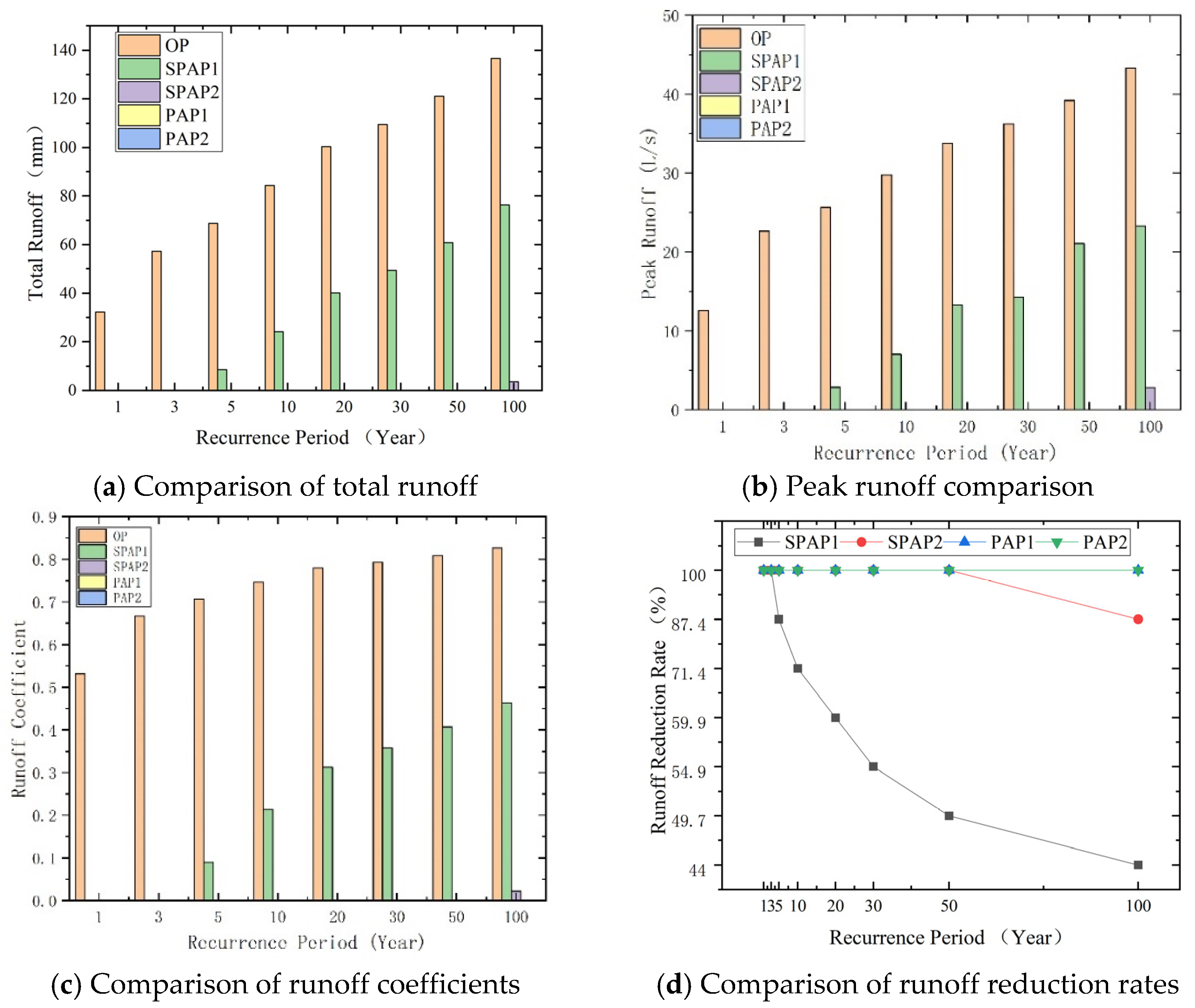
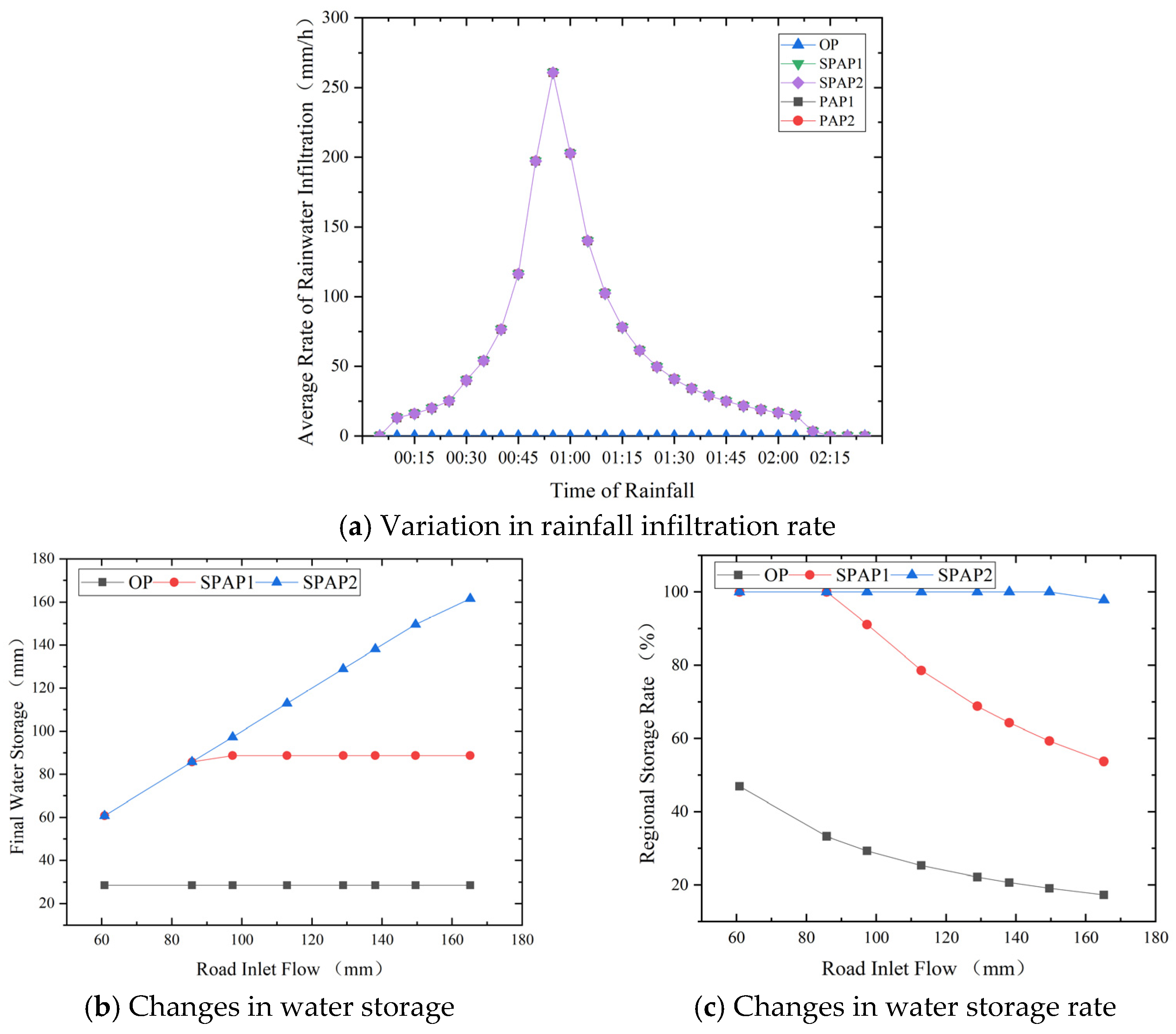
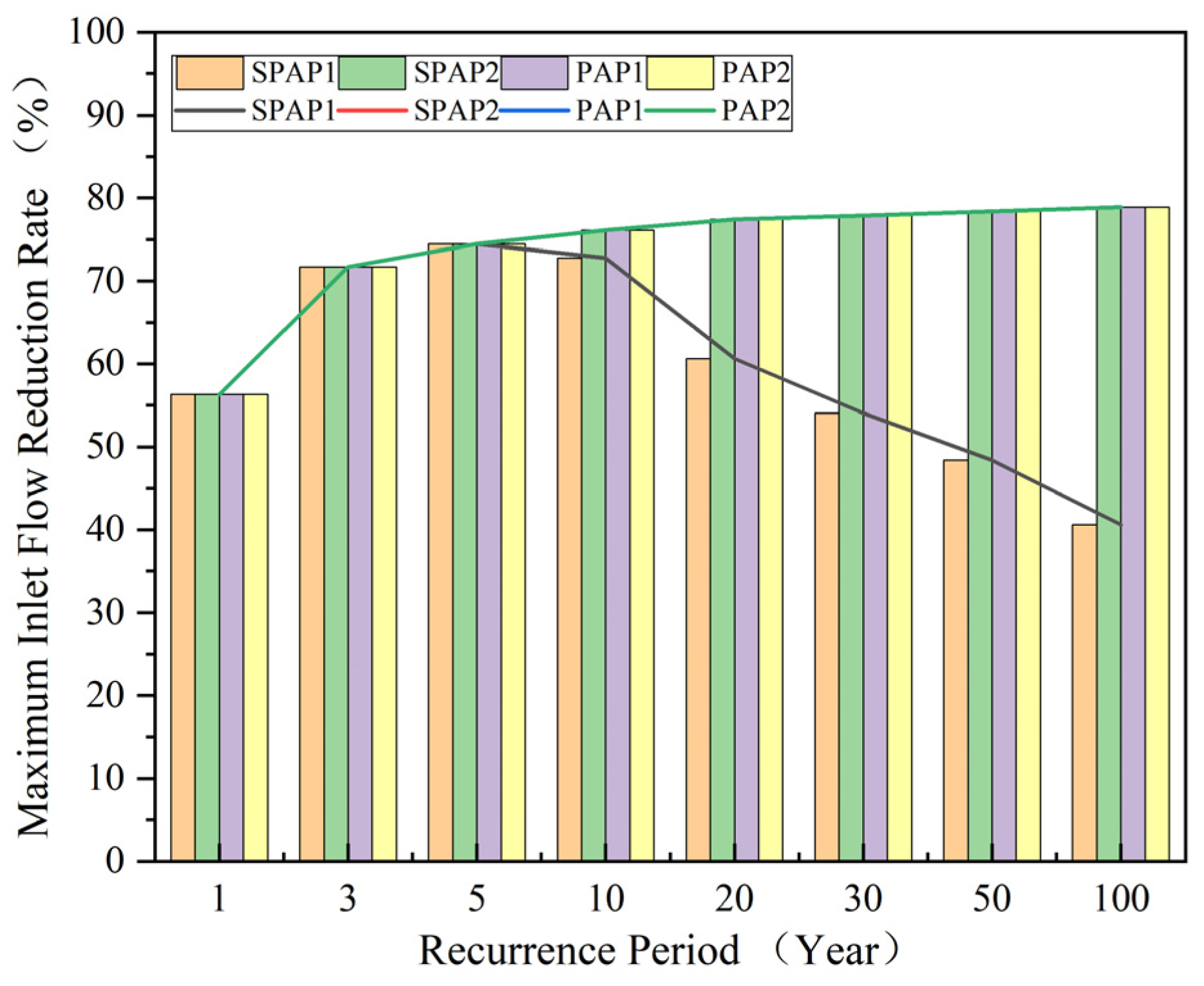
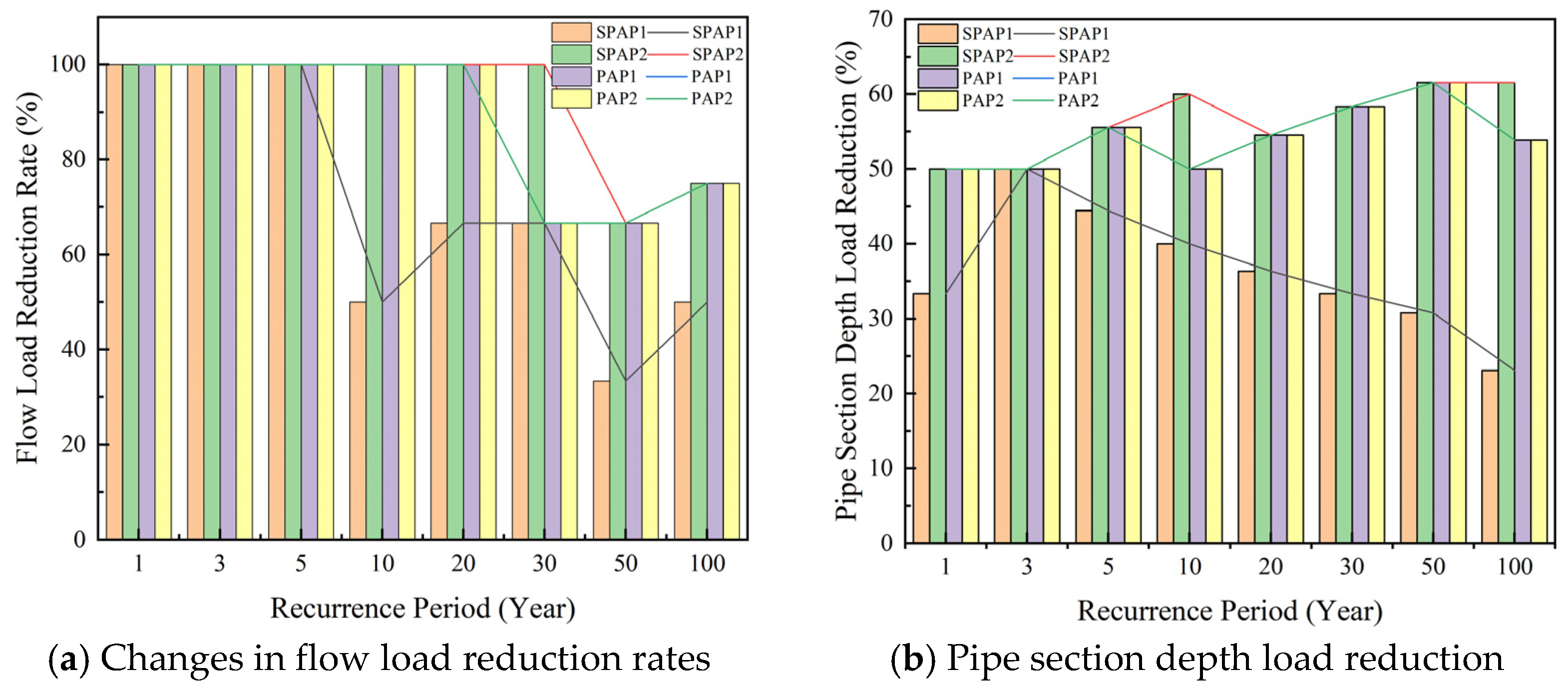

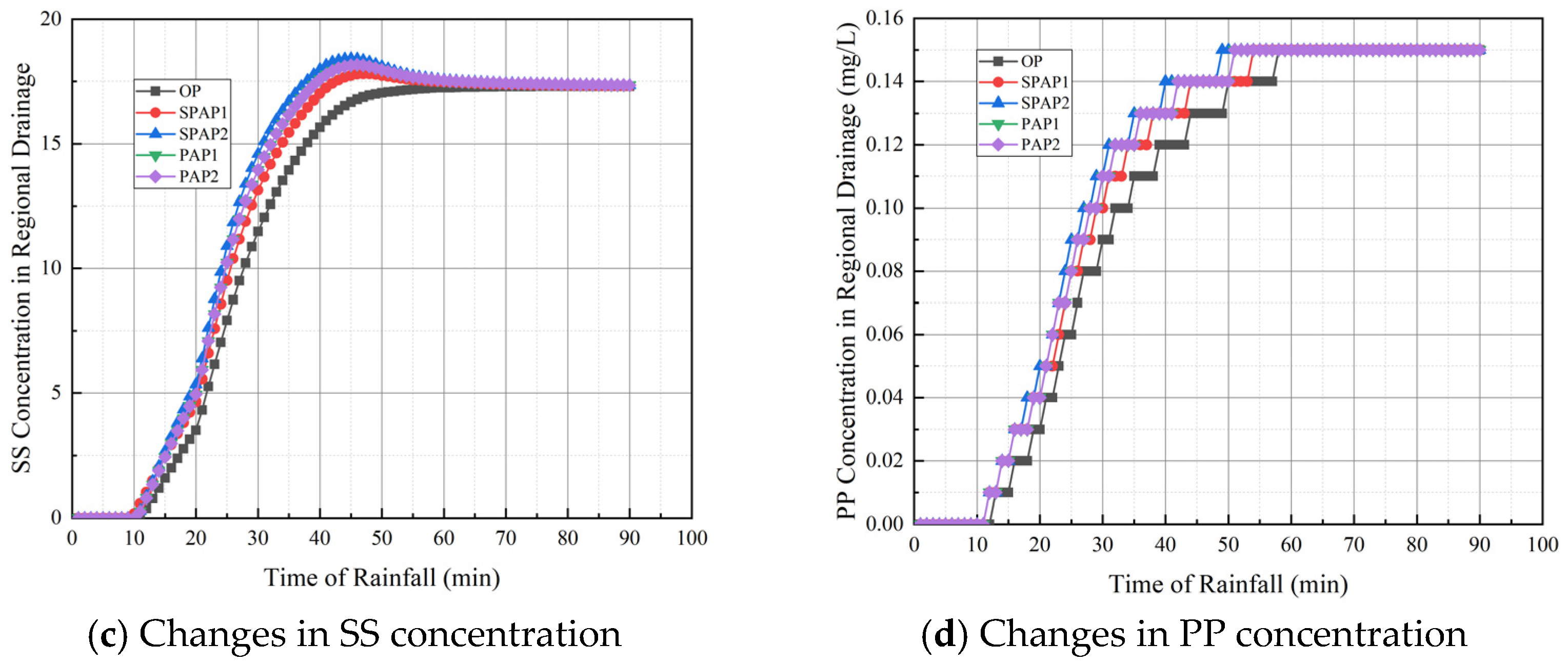
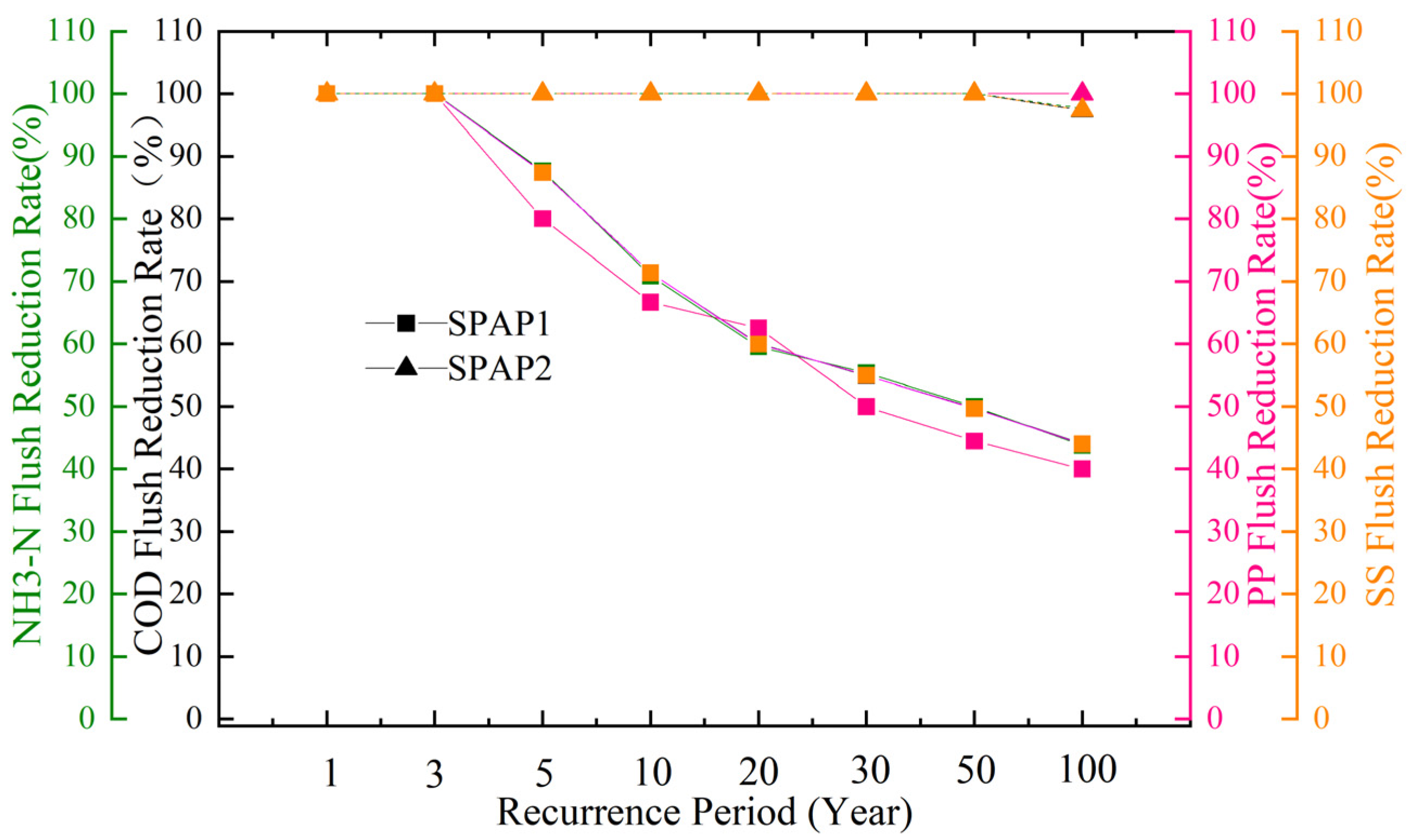


| Land Use Type | Manning’s Coefficient | |
|---|---|---|
| SWMM Recommended Values | Model Values | |
| Permeable zone | 0.15~0.41 | 0.15 |
| Impermeable zone | 0.013~0.024 | 0.012 |
| Rainwater network | 0.012~0.022 | 0.017 |
| Stratum | Property Parameter | SPAP1 | SPAP2 | PAP1 | PAP2 | OP |
|---|---|---|---|---|---|---|
| Surface Layer | Storage Depth (mm) | 5 | ||||
| Surface Manning’s Coefficient | 0.012 | |||||
| Surface Slope (%) | 2 | |||||
| Pavement Layer | Pavement Thickness (mm) | 140 | 140 | 140 | 340 | 140 |
| Composite Pore Ratio | 0.265 | 0.265 | 0.265 | 0.265 | 0.280 | |
| Impermeable Surface Fractions | 0 | 0 | 0 | 0 | 0 | |
| Permeation Rate (mm/h) | 479.6 | 479.6 | 479.6 | 453.5 | 271.6 | |
| Aquifer | Storage thickness (mm) | 250 | 550 | 700 | 600 | 0 |
| Porosity Ratio | 0.278 | 0.301 | 0.325 | 0.322 | 0.24 | |
| Seepage Rate (mm/h) | 0 | 0 | 359.7 | 359.7 | 0 | |
| Drain Culvert | Flow Coefficient | 3.2 | 3.2 | / | / | / |
| Drainage Index | 0.5 | 0.5 | / | / | / | |
| Offset Height (mm) | 0 | 0 | / | / | / | |
| Recurrence Period | Road Surface Type | COD/kg | NH3-N/kg | PP/kg | SS/kg |
|---|---|---|---|---|---|
| 1 | SPAP1 | 0 | 0 | 0 | 0 |
| SPAP2 | 0 | 0 | 0 | 0 | |
| PAP1 | 0 | 0 | 0 | 0 | |
| PAP2 | 0 | 0 | 0 | 0 | |
| OP | 0.956 | 0.12 | 0.008 | 1.116 | |
| 3 | SPAP1 | 0 | 0 | 0 | 0 |
| SPAP2 | 0 | 0 | 0 | 0 | |
| PAP1 | 0 | 0 | 0 | 0 | |
| PAP2 | 0 | 0 | 0 | 0 | |
| OP | 1.696 | 0.216 | 0.016 | 1.98 | |
| 5 | SPAP1 | 0.256 | 0.032 | 0.004 | 0.3 |
| SPAP2 | 0 | 0 | 0 | 0 | |
| PAP1 | 0 | 0 | 0 | 0 | |
| PAP2 | 0 | 0 | 0 | 0 | |
| OP | 2.04 | 0.26 | 0.02 | 2.38 | |
| 10 | SPAP1 | 0.716 | 0.092 | 0.008 | 0.836 |
| SPAP2 | 0 | 0 | 0 | 0 | |
| PAP1 | 0 | 0 | 0 | 0 | |
| PAP2 | 0 | 0 | 0 | 0 | |
| OP | 2.504 | 0.316 | 0.024 | 2.92 | |
| 20 | SPAP1 | 1.192 | 0.152 | 0.012 | 1.392 |
| SPAP2 | 0 | 0 | 0 | 0 | |
| PAP1 | 0 | 0 | 0 | 0 | |
| PAP2 | 0 | 0 | 0 | 0 | |
| OP | 2.98 | 0.376 | 0.032 | 3.476 | |
| 30 | SPAP1 | 1.464 | 0.184 | 0.016 | 1.708 |
| SPAP2 | 0 | 0 | 0 | 0 | |
| PAP1 | 0 | 0 | 0 | 0 | |
| PAP2 | 0 | 0 | 0 | 0 | |
| OP | 3.248 | 0.412 | 0.032 | 3.792 | |
| 50 | SPAP1 | 1.804 | 0.228 | 0.02 | 2.108 |
| SPAP2 | 0 | 0 | 0 | 0 | |
| PAP1 | 0 | 0 | 0 | 0 | |
| PAP2 | 0 | 0 | 0 | 0 | |
| OP | 3.592 | 0.456 | 0.036 | 4.188 | |
| 100 | SPAP1 | 2.268 | 0.288 | 0.024 | 2.648 |
| SPAP2 | 0.108 | 0.012 | 0 | 0.124 | |
| PAP1 | 0 | 0 | 0 | 0 | |
| PAP2 | 0 | 0 | 0 | 0 | |
| OP | 4.052 | 0.512 | 0.04 | 4.728 |
Disclaimer/Publisher’s Note: The statements, opinions and data contained in all publications are solely those of the individual author(s) and contributor(s) and not of MDPI and/or the editor(s). MDPI and/or the editor(s) disclaim responsibility for any injury to people or property resulting from any ideas, methods, instructions or products referred to in the content. |
© 2025 by the authors. Licensee MDPI, Basel, Switzerland. This article is an open access article distributed under the terms and conditions of the Creative Commons Attribution (CC BY) license (https://creativecommons.org/licenses/by/4.0/).
Share and Cite
Wei, D.; Xu, J.; Liu, Q.; Gu, S.; Lv, Y.; Xie, J. Investigation of the Impact of Improving the Hydrological Quality of Permeable Asphalt Pavement Based on the SWMM. Water 2025, 17, 3347. https://doi.org/10.3390/w17233347
Wei D, Xu J, Liu Q, Gu S, Lv Y, Xie J. Investigation of the Impact of Improving the Hydrological Quality of Permeable Asphalt Pavement Based on the SWMM. Water. 2025; 17(23):3347. https://doi.org/10.3390/w17233347
Chicago/Turabian StyleWei, Dingbing, Jinwei Xu, Qiang Liu, Sheng Gu, Yanwen Lv, and Jianguang Xie. 2025. "Investigation of the Impact of Improving the Hydrological Quality of Permeable Asphalt Pavement Based on the SWMM" Water 17, no. 23: 3347. https://doi.org/10.3390/w17233347
APA StyleWei, D., Xu, J., Liu, Q., Gu, S., Lv, Y., & Xie, J. (2025). Investigation of the Impact of Improving the Hydrological Quality of Permeable Asphalt Pavement Based on the SWMM. Water, 17(23), 3347. https://doi.org/10.3390/w17233347







